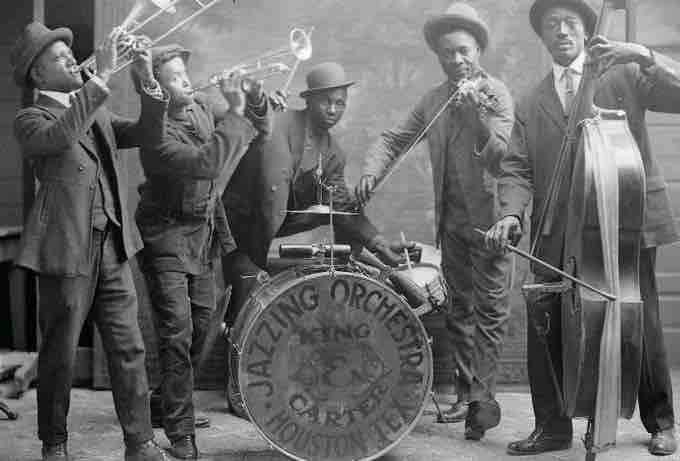If freedom was the mindset of the Roaring Twenties, then Jazz was the soundtrack. The Jazz Age was a cultural period and movement that took place in America during the 1920s from which both new styles of music and dance emerged. Largely credited to African-Americans employing new musical techniques with traditional African traditions, Jazz soon expanded to America's white middle class.
Birth of Jazz
Following World War I there was a mass migration of Jazz musicians from New Orleans to major northern cities like Chicago and New York, leading to a wider dispersal of Jazz as different styles developed in different cities. As the 1920s progressed, Jazz rose in popularity and helped to generate a cultural shift. Because of its popularity in speakeasies, illegal nightclubs where alcohol was sold during Prohibition, and its proliferation due to the emergence of more advanced recording devices, Jazz became very popular in a short amount of time, with stars including Duke Ellington, Cab Calloway and Chick Webb. Several famous entertainment venues such as the Apollo Theater and the Cotton Club came to epitomize the Jazz Age.
Cab Calloway
Cab Calloway became one of the most popular musicians of the Jazz Age in the 1920s.
Growth of Jazz
African-American Jazz was played more frequently on urban radio stations than on its suburban counterparts. Young people of the 1920s were influenced by Jazz to rebel against the traditional culture of previous generations, a rebellion that went hand-in-hand with fads such as the bold fashion statements of the Flappers and new radio concerts.
Dances like the Charleston, developed by African-Americans, instantly became popular among different demographics, including young white people. With the introduction of large-scale radio broadcasts in 1922, Americans were able to experience different styles of music without physically visiting a Jazz club. Through its broadcasts and concerts, the radio provided Americans with a trendy new avenue for exploring unfamiliar cultural experiences from the comfort of their living room. The most popular type of radio show was a "potter palm," an amateur concert and big-band Jazz performance broadcast from New York and Chicago.

The King & Carter Jazzing Orchestra, 1921
During the Jazz Age, popular music included current dance songs, novelty songs, and show tunes.
Due to the racial prejudice prevalent at most radio stations, white American Jazz artists received much more air time than black Jazz artists such as Louis Armstrong, Jelly Roll Morton and Joe "King" Oliver. Big-band Jazz, like that of James Reese in Europe and Fletcher Henderson in New York, was also popular on the radio and brought an African-American style and influence to a predominantly white cultural scene.
Jelly Roll Blues
"The Jelly Roll Blues" was one of the first Jazz songs to reach a widespread audience through radio play.
Flappers and Ladies of Jazz
The surfacing of Flappers, women noted for their flamboyant style of dress and progressive attitudes and modernized morals, began to captivate society during the Jazz Age. This coincided with a period in American society during which many more opportunities became available for women, in their social lives and especially in the entertainment industry.
Several famous female musicians emerged during the 1920s, including Bessie Smith, who garnered attention not only because she was a great singer, but also because she was a black woman. It was not until the 1930s and 1940s, however, that female Jazz and Blues singers such as Smith, Ella Fitzgerald and Billie Holiday were truly recognized and respected as successful artists throughout the music industry. Their persistence paved the way for many more female artists who came afterward.
Bessie Smith
The music of singer Bessie Smith was immensely popular during the Jazz Age and she both influenced and paved the way for generations of female artists.
Although the Jazz era ended as the Great Depression struck and victimized America throughout the 1930s, Jazz has lived on in American popular culture and remains a vibrant musical genre to this day.